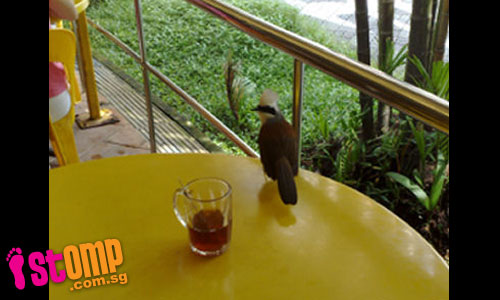
STOMPer Ornithologist was surprised to see this laughing thrush at a Bukit Batok coffee shop as it is rarely seen in urban areas. He says:
"These pictures were taken at a coffee shop at Blk 289H, at Bt Batok St 25.
"Last week I was sipping my coffee at the shop when I spotted this white-crested laughing thrush (Garrulax leucolophus) perched on a metal railing.
"Being a friendly bird it jumped onto the table and was eyeing my bread and coffee.
"I usually see this bird in the nature parks but this was the first time I see it at a coffee shop.
"The laughing thrush is a colourful and musical bird.
"Its usual habitat is the dense forest abundant with bamboo and it feeds mainly on fruit, insects and nectar."
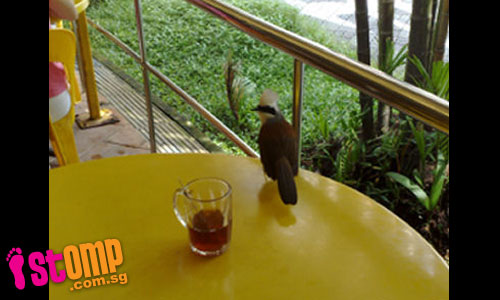

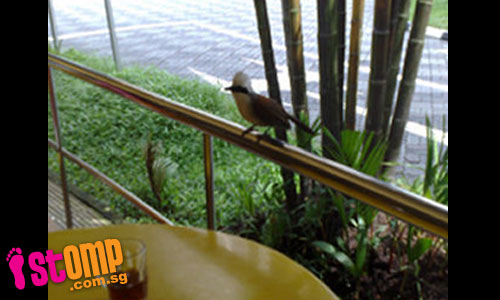
The white-crested laughingthrush is not native to Singapore; while it ranges from the Himalayas to southern China and much of mainland Southeast Asia, it is absent from peninsular Thailand and the Malay Peninsula. The population in Singapore originated from escaped and released pets, and was first recorded in the late 1980s in Bukit Batok Nature Park. This species is now considered to be a common introduced resident throughout mainland Singapore. I myself have seen white-crested laughingthrush in the Kent Ridge area, and just last Sunday, I had the pleasure of watching a trio of these birds foraging next to a stream in the Bukit Timah Nature Reserve.

This is an audio recording of white-crested laughingthrush in Cambodia. Listen up for the calls of this bird, especially if you are in Bukit Batok, Bukit Timah, or Southern Ridges.
(Taken from xeno-canto Asia)

Bukit Batok;
(Photo by myrontay)

The birds in Singapore belong to the subspecies diardi, which is native to much of Thailand, Indochina and south China.
Phutthamonthon, Thailand;
(Photo by somchai@2008)

Nominate subspecies (Garrulax leucolophus leucolophus), Ramnagar, India;
(Photo by Abhishek unplugged!)
Interestingly enough, a great proportion of the images of this species on Flickr and the Oriental Bird Club Image Database were taken in Singapore; only a small handful of photos were taken within countries like India and Thailand. This either goes to show that there is a large proportion of tech-savvy photographers in Singapore compared to other countries, or that the white-crested laughingthrush is more easily encountered here than within its native range.
Laughingthrushes are a large group of birds found throughout much of tropical and warm temperate Asia, with the greatest diversity found in the Himalayas and southern China. The Wikipedia page currently lists 64 species, and more species are constantly being described and named. Traditionally, they form a single genus (Garrulax) belonging to the babbler family (F. Timaliidae). However, genetic research has revealed that many species usually thought of as babblers do not actually belong to this family, and are more closely related to other passerine families, making the Timaliidae a paraphyletic group; under some classification schemes, laughingthrushes themselves are split off as a separate family of their own, the Garrulacidae. Even Garrulax itself is a polyphyletic assemblage, and some have proposed splitting it into as many as 11 distinct genera. The Wikipedia pages on laughingthrushes and babblers contain more details and references. Basically, the systematics of passerine birds is a horrible mess.
Another non-native species of laughingthrush is found in Singapore, the Chinese Hwamei (Leucodioptron canorum, formerly Garrulax canorus). Like the white-crested laughingthrush, this native of China, Vietnam and Laos entered Singapore via the caged songbird trade, and was first recorded locally in the 1980s from many locations, including the islands of Sentosa, St. John's Island and Pulau Ubin.
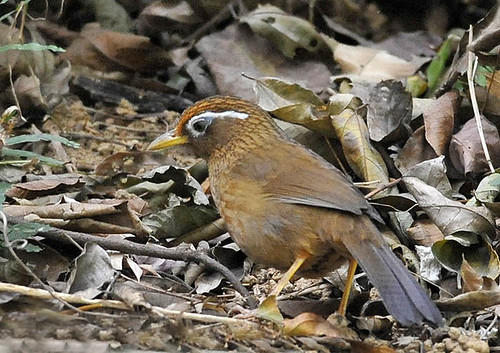
Hong Kong;
(Photo by neilfif11)
However, the Chinese hwamei does not seem to have established itself as well as the white-crested laughingthrush. Since the 1990s, this species has been in sharp decline; the last mainland sighting was at Poyan in 1997, and the only extant population now lingers on in Sentosa. However, this same species has done very well in Hawaii, where it was introduced in the early 20th century.
A third species of laughingthrush, the greater necklaced laughingthrush (Garrulax pectoralis), has also been recorded in Singapore. Like the white-crested laughingthrush, this species is native to the Himalayas, southern China, and parts of Thailand and Indochina.

Kaeng Krachan, Thailand;
(Photo by somchai@2008)
Like the previous 2 species, the greater necklaced laughingthrush was first recorded in the 1980s, and since then, there have been sightings at Mount Faber, Kent Ridge, and Telok Blangah. While breeding has been reported, this species remains an uncommon escapee.
The fourth and final species of laughingthrush recorded in Singapore is the black-throated laughingthrush (Dryonastes chinensis, formerly Garrulax chinensis), native to southern China and parts of Indochina.
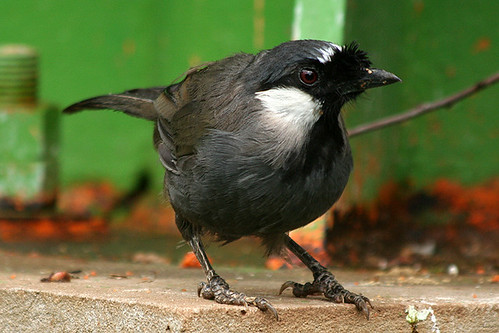
Kunming, China;
(Photo by iamtonyang)
There have been only a small handful of sightings of this species; the first record was at Upper Seletar Reservoir in 1989, 2 were spotted at Kent Ridge in 1993, 3 were seen at Telok Blangah in 1998, and a solitary individual was reported at Mount Faber in 2003.
The laughingthrushes are just 4 out of a long list of non-native bird species that have been recorded here in Singapore. It is interesting that the white-crested laughingthrush has managed to flourish quite well, unlike the Chinese hwamei. The very different fates of these 2 species are just 2 possible scenarios that can be played out when an exotic species is introduced to a new location, whether deliberately or by accident. Most eventually die out, being unable to adapt to the new environment, or have had little success at finding suitable mates and reproducing; it is likely that the black-throated laughingthrush falls within this category.
Some species do manage to reproduce, but for some reason, are unable to form a self-sustaining population; in such cases, the population is either supplemented by new releases and escapees, or numbers eventually peter and die out. It is probable that even without human intervention, the Chinese hwamei will eventually become extinct locally.
Then there are others that not only manage to establish breeding populations, but become common elements in their new habitats, like the white-crested laughingthrush.
I won't be surprised if the white-crested laughingthrush presents competition for resources that some of our more threatened native species could do without. However, unlike other non-native birds such as Javan myna (Acridotheres javanicus), feral pigeon (Columba livia), or house crow (Corvus splendens), the white-crested laughingthrush is regarded as a benign presence, and so far, it is not thought to present any threat to the survival of native birds.